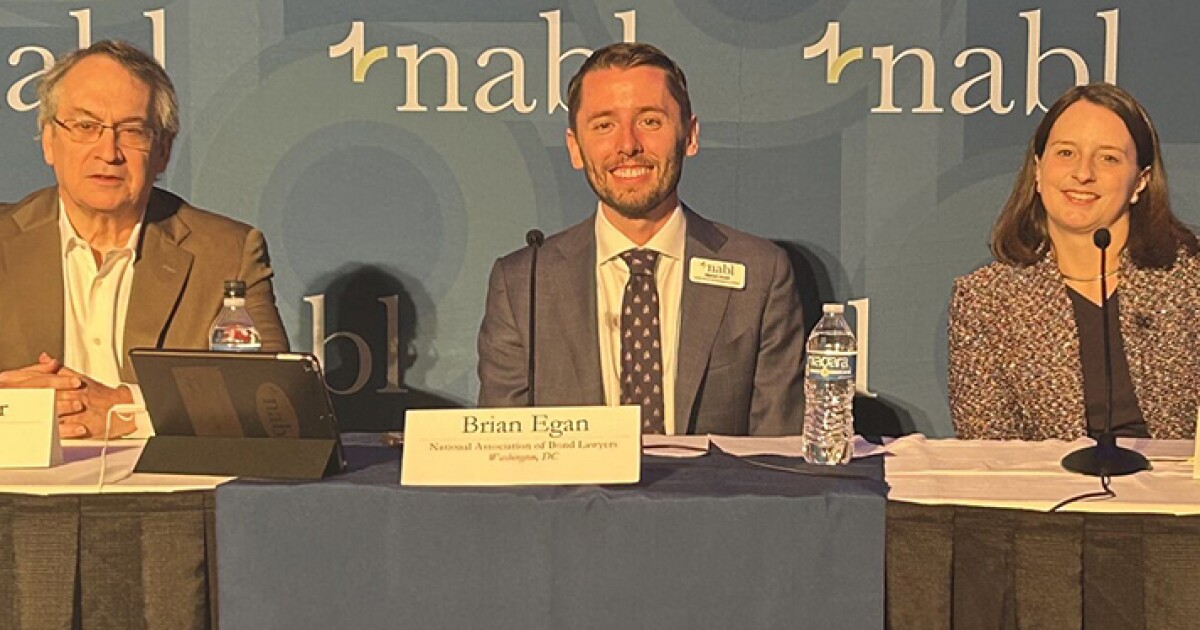Muni industry needs to advocate for tax-exemption, NABL panel says
5 min read

The death knell isn’t ringing for the tax-exemption on municipal bonds, according to a panel at the National Association of Bond Lawyers conference, at least not yet — although the panel suggested the industry remind lawmakers of the role bonds play in their communities.
The exemption remains an issue as policymakers will need to find ways to pay for an extension of expiring Tax Cuts and Jobs Act provisions.
Former Hill staffers Katherine Monge and Mark Prater agreed the municipal bond industry needs to engage lawmakers through specific stories about the role bonds play in communities across America, and especially in lawmakers’ respective districts, during the discussion on a panel moderated by NABL Governmental Affairs Director Brian Egan.
National Association of Bond Lawyers
“If something’s on a list and it has a score, how much it raises, it is vulnerable,” said Monge, a partner at Capitol Tax Partners in Washington, D.C., and previously chief policy advisor on tax, trade, economic and budgetary issues to former House Speaker Nancy Pelosi.
“People don’t have time to be overly creative when they’re putting together a package like this. … For example, [the Congressional Budget Office], in their 2022 Options for Reducing the Deficit, scores getting rid of private-activity bonds as raising $35 billion over 10 years. So if policymakers are looking for $4 trillion, anything that raises a large number has to be discussed,” said Monge, who was a lead negotiator on the Inflation Reduction Act.
The expiring TCJA provisions are “a big policy decision facing Congress, and it will depend a lot on how the election turns out,” said Prater, managing director of tax policy services in PwC’s Washington national tax services practice and previously chief tax counsel and deputy staff director on the Senate Finance Committee’s Republican staff.
“My experience in working on deals over the years … [is] there always has to be ultimately a first call [of] what will the political traffic bear in terms of a net number, either an increase or decrease on the tax line. … It always comes down to, what is that net number. And then the lawmakers, especially the tax policymakers, have to back into that number,” said Prater, who served as staff director for the Joint Select Committee on Deficit Reduction.
Monge said no matter how the election turns out, there could be “significant bumpiness” in Congress — “which is not to say that the process won’t ultimately end in a good decision.”
Already known is that Sen. Mitch McConnell, R-Kentucky, is stepping down and there will be a new administration in the White House and a new Treasury secretary, as well as other changes.
“This isn’t the same conversation that you had in 2017,” she said. “Both parties are a little different. You’ve seen a rise in populism, more of a focus on workers. I think you have bipartisanship on protectionist trade policies and more discussions around fiscal responsibility. All of which suggests that how you get to a decision on what to do on any expiring provisions is going to be hard.
“You can also expect very tight majorities in both the House and Senate,” she added. “So every senator, every House member, will have much more of a say in the final product.”
Egan noted, simply extending the expiring TCJA provisions will cost an estimated $3.8 trillion, so legislators will likely be seeking pay-fors in the trillions, not billions, he said.
“They have two choices,” Prater said. “They could either go and get aggressive, in which case” the municipal bond industry, including NABL, should be concerned, because it’s more ambitious and they will then need more and larger pay-fors.
“Or they could do a shorter-term deal. Just cut down on the number of years,” he continued. “Of course, the price of doing that is the stability of the system and the effectiveness of the incentives.”
Monge pointed out no Democrats voted for TCJA, so they have no ownership stake. And while “improving” the SALT deduction, the child tax credit and the earned income tax credit, as well as putting more money into development, are all priorities for Democrats, their preferred pay-fors — raising taxes on corporations and high net worth individuals — have proved tough to get through the Senate.
“The other reason why you’re always concerned is that because of staff turnover and the average age of staff — some of them have never bought a muni bond — they haven’t thought about it before,” she said. “And so just constantly educating members and staff about the importance of bonds and what they do is the way that you keep yourself out of bills. You know you’re vulnerable because previous tax reform proposals have looked at bonds.”
Working in the municipal bond industry’s favor is, many members of Congress used to be state legislators or mayors, and therefore understand the advantages of muni bonds. There are also lawmakers in Congress who repeatedly have defended the tax-exemption, Monge noted.
But Prater raised the prospect of lower-tier provisions whose loss could result in a smaller market. It’s the concept of “death by a thousand cuts,” as Egan put it, like the loss of advance refundings in 2017 — a blow to the market that was by no means a paper cut, he said.
“You have to explain to members and staff, ‘If you do this, this is what’s going to happen,'” Monge said. “The more you have relationships with a couple members, the more likely they are to say, ‘Hey, they’re looking at this. They’re tinkering over there.'”
You also have to show how your issue impacts their community, she said, “so that you get advanced warnings of things that are changing … as the bill is moving and moving quickly.”
It will be hard for lawmakers to justify a bill that doesn’t touch one industry but impacts most others, she added. Muni bond advocates will have to be prepared to answer the question: How is my industry different?
“The exemption is a bedrock principle of the Internal Revenue Code,” Prater said. “But you’ve got to tell your story to members about what this means, why it’s a good thing to have, how it fits within the larger system of federalism and state and local finance. Connect the importance from a policy standpoint to home, to the constituents, what it means in those districts.”







